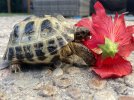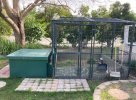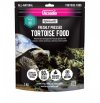kurttheturt
New Member
Hello everyone! This is my first post on this forum so excuse me if I make any mistakes, I’m also on mobile.
Basically to explain this post:
Sometimes I feel like a really terrible tortoise owner even though I do my research I feel like I’m not giving him a good enough quality of life.
For background information:
I have an around 2 year old Russian tortoise. I’ve had him for a year now, and for the first half of owning him he was indoors in an approximately 12 gallon tank. My dad and I then built him an outdoor enclosure but it isn’t much bigger at 2x4 in size, and I have plans to build a larger one but I don’t know if I want it inside or outside, I’ll explain more later on why. I have always provided him with fresh water and food every day or every other day, and I dust his food with calcium powder and soak him once a month as well as take him out to explore the backyard. He doesn’t have any pyramiding from what I can tell. I use a mix of coco fiber and cypress mulch for his substrate. I live in Los Angeles, California so the weather is generally on the mild side.
Concerns:
I know that the enclosure is too small and I am going to build a larger one but I don’t really have space in my house for the recommended 4x8 size, and I am worried to put him outside especially as winter is coming up and I’m not the best at carpentry or wiring for outdoor lamps and stuff, and I haven’t hibernated him before and am frankly a bit scared to do so in fear of doing it wrong. Does anyone have any tips for this? Are there any good pre built tortoise tables or easy to make setups that work for a male Russian that you guys could recommend? Another concern of mine is that when I let him out to wander, he always tries to eat rocks and pebbles. I’ve looked it up and it said it may be due to calcium deficiency but I always make sure I give him calcium in the form of powder and cuttlefish bone, so what could be the cause of this? Another concern is that I’m not feeding him a wide enough variety of foods. I mainly feed him spring mix as I don’t really have access to a home garden but I’ve been trying to research safe things I can feed him from around my neighborhood. I do feed him hibiscus when the flowers bloom though.
Questions:
How often should I be feeding him? I generally feed him every other day though sometimes I go a bit longer and he overall seems healthy, he’s a 2 year old Russian just as a reminder and he’s about 6 inches long.
Any recommendations for good enrichment activities? He’s usually shy when I pick him up for the first time in a while but he perks up after a bit. His enclosure has places for him to dig and hide and not much else, should I add a wheel or something?
Is soaking once a month okay, or should I do it more often?
What are more tips you guys have should I keep him outside? I have an enclosed backyard but there are a lot of outdoor cats that come by and I’m also worried about birds. I’m just overall scared of housing him outside because of nature and that I’ll make a mistake somewhere along the lines.
Really, why does he keep trying to eat pebbles? It’s all he does!
I think that’s all for now, I hope you guys don’t see me as a terrible and cruel tortoise owner because I’m genuinely trying my best with what resources I have and I can provide more for him but I’ve been at a loss of how to do so and I should’ve posted here sooner. I genuinely love my tortoise and I did do research before I got him but as he’s gotten bigger I’m needing to adapt some more. Please try to be nice in the replies if possible… thank you for taking the time to read my post and I look forward to seeing the responses I get! Attached is a photo of Kurtis. Would someone please let me know if his scutes look healthy? If there’s any pyramiding his shell has generally looked this way since I got him, and he was already around a year and a half when I did.
Basically to explain this post:
Sometimes I feel like a really terrible tortoise owner even though I do my research I feel like I’m not giving him a good enough quality of life.
For background information:
I have an around 2 year old Russian tortoise. I’ve had him for a year now, and for the first half of owning him he was indoors in an approximately 12 gallon tank. My dad and I then built him an outdoor enclosure but it isn’t much bigger at 2x4 in size, and I have plans to build a larger one but I don’t know if I want it inside or outside, I’ll explain more later on why. I have always provided him with fresh water and food every day or every other day, and I dust his food with calcium powder and soak him once a month as well as take him out to explore the backyard. He doesn’t have any pyramiding from what I can tell. I use a mix of coco fiber and cypress mulch for his substrate. I live in Los Angeles, California so the weather is generally on the mild side.
Concerns:
I know that the enclosure is too small and I am going to build a larger one but I don’t really have space in my house for the recommended 4x8 size, and I am worried to put him outside especially as winter is coming up and I’m not the best at carpentry or wiring for outdoor lamps and stuff, and I haven’t hibernated him before and am frankly a bit scared to do so in fear of doing it wrong. Does anyone have any tips for this? Are there any good pre built tortoise tables or easy to make setups that work for a male Russian that you guys could recommend? Another concern of mine is that when I let him out to wander, he always tries to eat rocks and pebbles. I’ve looked it up and it said it may be due to calcium deficiency but I always make sure I give him calcium in the form of powder and cuttlefish bone, so what could be the cause of this? Another concern is that I’m not feeding him a wide enough variety of foods. I mainly feed him spring mix as I don’t really have access to a home garden but I’ve been trying to research safe things I can feed him from around my neighborhood. I do feed him hibiscus when the flowers bloom though.
Questions:
How often should I be feeding him? I generally feed him every other day though sometimes I go a bit longer and he overall seems healthy, he’s a 2 year old Russian just as a reminder and he’s about 6 inches long.
Any recommendations for good enrichment activities? He’s usually shy when I pick him up for the first time in a while but he perks up after a bit. His enclosure has places for him to dig and hide and not much else, should I add a wheel or something?
Is soaking once a month okay, or should I do it more often?
What are more tips you guys have should I keep him outside? I have an enclosed backyard but there are a lot of outdoor cats that come by and I’m also worried about birds. I’m just overall scared of housing him outside because of nature and that I’ll make a mistake somewhere along the lines.
Really, why does he keep trying to eat pebbles? It’s all he does!
I think that’s all for now, I hope you guys don’t see me as a terrible and cruel tortoise owner because I’m genuinely trying my best with what resources I have and I can provide more for him but I’ve been at a loss of how to do so and I should’ve posted here sooner. I genuinely love my tortoise and I did do research before I got him but as he’s gotten bigger I’m needing to adapt some more. Please try to be nice in the replies if possible… thank you for taking the time to read my post and I look forward to seeing the responses I get! Attached is a photo of Kurtis. Would someone please let me know if his scutes look healthy? If there’s any pyramiding his shell has generally looked this way since I got him, and he was already around a year and a half when I did.



